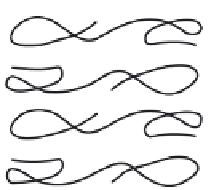Biomedical Engineering Reference
In-Depth Information
RE
Polyanion
Polycation
Polyanion
Polycation
Gate insulator
EIS sensor
Si
FIGURE 7.10
Schematic sensor build-up of an FED with layer-by-layer adsorbed PE multilayers of
polycationic and polyanionic composition.
constant-capacitance, impedance-spectroscopy and atomic-force microscopy meth-
ods. Both the effect of the number and polarity of the polyelectrolyte layers and the
infl uence of the DNA-hybridization event on the shift of the capacitance-voltage
curves along the capacitance and voltage axis have been investigated.
Figure 7.11a shows a typical set of
C-V
curves for a p-Si-SiO
2
-Ta
2
O
5
sensor - as
prepared and after the adsorption of each PE layer (PAH and PSS, respectively). As
it has been discussed in section 7.2, the
C-V
measurements allow to observe both the
fl at-band voltage change (
C
) in
the accumulation region of the
C-V
curve, induced by charged macromolecules. The
shifts along the voltage axis can be clearly recognized from the zoomed graph in the
depletion region (
∆
V
fb
) and the changes in the maximum capacitance (
∆
60% of the
C
max
) (see Fig. 7.11a, right); their direction depends on
the sign of the PE layer's charge.
Alternating potential shifts of about 30-90 mV have been observed after the adsorp-
tion of each polycation and polyanion layer. In the case of adsorption of the positively
charged PAH, the potential shifts into the direction as for an additional positive charge
of the Ta
2
O
5
surface of the FED, whereas the direction of the potential change after
adsorption of the negatively charged PSS corresponds to the case of a negative Ta
2
O
5
surface charge.
At the same time, Fig. 7.11a also shows some small changes in the maximum (or
geometrical) capacitance in the accumulation range of the
C-V
curve (decrease of
about up to
2.5%). When assuming the adsorbed PE layers as homogeneous dielectric
fi lms of defi ned thickness and dielectric constant, the geometrical capacitance effect
due to the additional eight PE layers should be somewhat larger as achieved in
this experiment. This can be attributed to the not completely dense structure of the

































































Search WWH ::

Custom Search